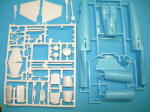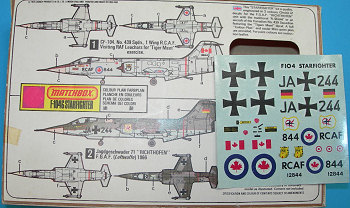
| KIT: | Matchbox 1/72 F-104G |
| KIT #: | PK-40 |
| PRICE: | $ |
| DECALS: | Two options |
| REVIEWER: | Victor Scheuerman |
| NOTES: | There are better 1/72 F-104s |

| HISTORY |
The F-104 originated in 1952 to fulfill a USAF requirement for a day superiority fighter, and after investigating a number of new ideas Lockheed produced a dramatic and startling design. It bore little resemblance to existing aircraft, having a tiny wing only 7’ 6” long with such a sharp edges that ground personnel had to be protected from injury by covers. This remarkable machine first flew in February 1954 and was operational service in January, 1958. In 1959 the LUFTWAFFE placed a development contract for a modified version of the F-105G which had fighter bomber and reconnaissance capability. As a result a European production programme was started involving aircraft resources in Germany, Belgium and Italy. (Thanks to the kit instructions.)
| THE KIT |
 Matchbox
offered a basic F-104 that was cleanly molded in 41 blue and white flash free
plastic with a few sink marks (upper fuselage) and a one-piece clear canopy. All
panel lines are engraved and there is some raised detail on the after burner and
tires. As was normal for the brand, the cockpit is very basic with just an
ejection seat that perhaps looks closer to the Martin-Baker variant then the
Lockheed seat and a nice pilot figure. There is a partial instrument panel
molded to the coaming.
Matchbox
offered a basic F-104 that was cleanly molded in 41 blue and white flash free
plastic with a few sink marks (upper fuselage) and a one-piece clear canopy. All
panel lines are engraved and there is some raised detail on the after burner and
tires. As was normal for the brand, the cockpit is very basic with just an
ejection seat that perhaps looks closer to the Martin-Baker variant then the
Lockheed seat and a nice pilot figure. There is a partial instrument panel
molded to the coaming.
The fuselage is made up of five separate pieces (the fuselage speed brakes are correctly molded closed) and the intake lips and one-piece main wings and tail wing attach to this assembly. On the plus side, all the gear wells are framed in but the nose bay is; too shallow, too long and features incorrect triangular shaped ends. The landing gear legs, tires, retraction arms and main gear doors look adequate, but the nose gear doors should be replaced. Having built a bevy of 1/72 scale Starfighters in the last two years I actually like that Matchbox has the main gear as two separate pieces that can be attached after painting; nice for a change.
 While
the Starfighter could carry a wide variety of stores on the fuselage and wing
stations, Matchbox offers only two Sidewinder ‘shapes’ for the wing-tip rails.
Assembly of the model is covered in nine well-drawn steps and detailed painting
notes are offered separately at the end.
While
the Starfighter could carry a wide variety of stores on the fuselage and wing
stations, Matchbox offers only two Sidewinder ‘shapes’ for the wing-tip rails.
Assembly of the model is covered in nine well-drawn steps and detailed painting
notes are offered separately at the end.
This kit offers two decal options. One is a natural metal finish Canadian aircraft of 439 (Sabre Toothed Tiger) Squadron with a Tiger Meet head displayed on the intakes. While the marking scheme is accurate, showing a Canadian 104 with sidewinders is not. There are three paint areas that are also incorrect. The main wings should have gloss white tops and gloss grey bottoms. Also, European based CF-104s have the tail planes painted white. The other option is the original standard camouflaged German from Jagdgeschwader 71 “Richthofen” circa 1966. Both options are displayed in full colour on the box back.
| CONCLUSIONS |
While this kit profile looks at first not too bad, the kit fuselage has a pronounced curved bulge along the bottom in the gear area that is incorrect. Other shape questions are the canopy is a not bulged and the fuselage forward section is pear shaped in lieu of being more rounded. These outline issues take some of the shine away and the older ESCI/AMT ERTL/Italeri is a better choice as is the much newer Hasegawa and Revell Germany kits.
August 2007
If you would like your product reviewed fairly and quickly by a site that has nearly 400,000 visitors a month, please contact me or see other details in the Note to Contributors.